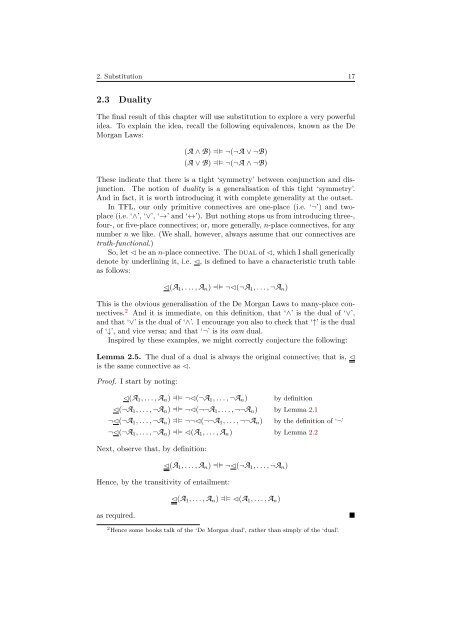Metatheory - University of Cambridge
Metatheory - University of Cambridge
Metatheory - University of Cambridge
You also want an ePaper? Increase the reach of your titles
YUMPU automatically turns print PDFs into web optimized ePapers that Google loves.
2. Substitution 17<br />
2.3 Duality<br />
The final result <strong>of</strong> this chapter will use substitution to explore a very powerful<br />
idea. To explain the idea, recall the following equivalences, known as the De<br />
Morgan Laws:<br />
(A ∧ B)<br />
(A ∨ B)<br />
⊨<br />
⊨<br />
⊨ ¬(¬A ∨ ¬B)<br />
⊨ ¬(¬A ∧ ¬B)<br />
These indicate that there is a tight ‘symmetry’ between conjunction and disjunction.<br />
The notion <strong>of</strong> duality is a generalisation <strong>of</strong> this tight ‘symmetry’.<br />
And in fact, it is worth introducing it with complete generality at the outset.<br />
In TFL, our only primitive connectives are one-place (i.e. ‘¬’) and twoplace<br />
(i.e. ‘∧’, ‘∨’, ‘→’ and ‘↔’). But nothing stops us from introducing three-,<br />
four-, or five-place connectives; or, more generally, n-place connectives, for any<br />
number n we like. (We shall, however, always assume that our connectives are<br />
truth-functional.)<br />
So, let ◁ be an n-place connective. The dual <strong>of</strong> ◁, which I shall generically<br />
denote by underlining it, i.e. ◁, is defined to have a characteristic truth table<br />
as follows:<br />
◁(A 1 , . . . , A n )<br />
⊨<br />
⊨ ¬◁(¬A 1 , . . . , ¬A n )<br />
This is the obvious generalisation <strong>of</strong> the De Morgan Laws to many-place connectives.<br />
2 And it is immediate, on this definition, that ‘∧’ is the dual <strong>of</strong> ‘∨’,<br />
and that ‘∨’ is the dual <strong>of</strong> ‘∧’. I encourage you also to check that ‘↑’ is the dual<br />
<strong>of</strong> ‘↓’, and vice versa; and that ‘¬’ is its own dual.<br />
Inspired by these examples, we might correctly conjecture the following:<br />
Lemma 2.5. The dual <strong>of</strong> a dual is always the original connective; that is, ◁<br />
is the same connective as ◁.<br />
Pro<strong>of</strong>. I start by noting:<br />
◁(A 1 , . . . , A n )<br />
◁(¬A 1 , . . . , ¬A n )<br />
¬◁(¬A 1 , . . . , ¬A n )<br />
¬◁(¬A 1 , . . . , ¬A n )<br />
Next, observe that, by definition:<br />
⊨<br />
⊨<br />
⊨<br />
⊨<br />
⊨ ¬◁(¬A 1 , . . . , ¬A n )<br />
by definition<br />
⊨ ¬◁(¬¬A 1 , . . . , ¬¬A n ) by Lemma 2.1<br />
⊨ ¬¬◁(¬¬A 1 , . . . , ¬¬A n ) by the definition <strong>of</strong> ‘¬’<br />
⊨ ◁(A 1 , . . . , A n ) by Lemma 2.2<br />
◁(A 1 , . . . , A n )<br />
⊨<br />
⊨ ¬◁(¬A 1 , . . . , ¬A n )<br />
Hence, by the transitivity <strong>of</strong> entailment:<br />
◁(A 1 , . . . , A n )<br />
⊨<br />
⊨ ◁(A 1 , . . . , A n )<br />
as required.<br />
■<br />
2 Hence some books talk <strong>of</strong> the ‘De Morgan dual’, rather than simply <strong>of</strong> the ‘dual’.
















